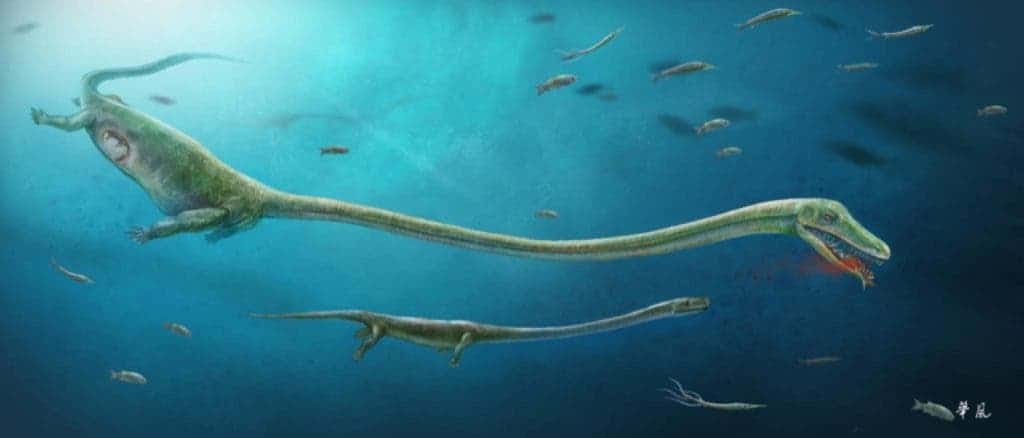A remarkable ‘terrible-headed lizard’ fossil found in China shows an embryo inside the mother — a clear evidence that some reptiles were giving birth to live babies.

Credit: Drawn by Dinghua Yang
A quarter billion years ago, what is now Southwest China was covered by a shallow sea. Within that sea, some pretty big and nasty-looking creatures roamed the days, including the Dinocephalosaurus. Dinocephalosaurus had a hugely elongated neck and liked to swallow its prey whole — this being a significant detail. Paleontologists have found a fossil of such a sea monster, which is exciting enough, but within it, they found something else: another fossil. At first, they thought it was the dinosaur’s lunch, but the embryo faced forward, as opposed to any potential prey which would be swallowed head-first. Making this distinction was not easy.
“I was not sure if the embryonic specimen was the last lunch of the mother or its unborn baby,” said Jun Liu, a paleontologist at the Hefei University of Technology in China, and leader of the study. “Upon closer inspection and searching the literature, I realized that something unusual had been discovered.” Furthermore, the somewhat curved position was typical for am embryo. “The curled posture of the embryonic skeleton is also typical for vertebrate embryos,” Liu said.
Professor Jonathan Aitchison, who was also involved in the study, said this provides the first evidence of live birth in a class of animals thought to only lay eggs.
“Live birth is well known in mammals, where the mother has a placenta to nourish the developing embryo,” Professor Aitchison said. “Live birth is also very common among lizards and snakes, where the babies sometimes ‘hatch’ inside their mother and emerge without a shelled egg.”
Dinocephalosaurus, which means “terrible-headed lizard”, was not technically a dinosaur — it preceded dinosaurs by a few million years. However, it does belong to a group called archosauromorpha, a clade that includes the animals which later became crocodiles, alligators, birds and of course, dinosaurs. Even by modern standards, finding a member of this clade giving birth to live babies would be unusual, but for a member this old it is indeed stunning.
Being an aquatic reptile, it would be expected of Dinocephalosaurus to lay its eggs on dry land, like turtles do. But because of its very particular shape and its long neck, it was completely unsuited for trips out of the water. When your neck is a third of your total body length, you’d much rather stay underwater, which is arguably why the creatures developed this birthing mechanism.
Professor Chris Organ from Montana State University, who also worked on the study, said evolutionary analysis showed that this instance of live birth was also associated with genetic sex determination.
Some reptiles today, such as crocodiles, determine the sex of their offspring by the temperature inside the nest,” he said. “We identified that Dinocephalosaurus, a distant ancestor of crocodiles, determined the sex of its babies genetically, like mammals and birds. This new specimen from China rewrites our understanding of the evolution of reproductive systems.”
But not everyone is convinced. Michael Caldwell, an expert in extinct marine reptiles and chair of the biological sciences department at the University of Alberta says that Choristodera, a group of semi-aquatic reptiles, gave birth to live young, too. The only question is whether they too can be placed under the archosauromorpha, which according to Caldwell, are “a giant grab bag” of seemingly disparate animals. But in the grand scheme of things, whether it’s Dinocephalosaurus or Choristodera that can lay a claim to fame is not relevant. What is important is understanding how environmental pressures pushed these creatures towards this unusual approach. Also, perhaps instead of wondering why these creatures did get pregnant, we should ask ourselves why their descendants don’t.
Journal Reference: Jun Liu, Chris L. Organ, Michael J. Benton, Matthew C. Brandley, Jonathan C. Aitchison. Live birth in an archosauromorph reptile. Nature Communications, 2017; 8: 14445 DOI: 10.1038/ncomms14445






